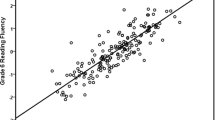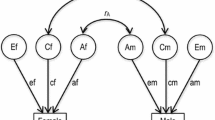Summary
A sample school population of 75 family units of equal size was investigated for expression of specific reading disability. 25.3% of the total children showed specific reading disability as defined in this study. By using spelling achievement as the criterion for the presence of the disability, the incidence of the disorder was shown to be much higher in certain families than in others, with clear sibling aggregation. The siblings of specific-reading-disability cases demonstrated lower spelling competence than the total siblings in normal families, even when well above a crippling level. Both within individual families and by grades, the spelling rating in relation to grade norms of the specific-reading-disability family cases with their siblings tended to decline with age, in contrast to normal families where it tended to improve with age. This pattern was even more striking if the greater language competence of females, now quite generally accepted and further supported by this study, was taken into account. It was demonstrated that the above patterns were not primarily a product of intelligence level or teaching methods. The bearing of these findings on the tenability of the most common, current hypotheses concerning causation was briefly discussed.
Similar content being viewed by others
References
Orton, S. T.: Reading, Writing and Speech Problems in Children. N. Y., Norton, 1937. (reprinted 1961)
Hallgren, B.: Specific dyslexia. Acta psychiat. Scand. Suppl. 65, 1950.
Gallagher, J. R.: Specific language disability (dyslexia). Clin. Proc. Child. Hosp. (Boston) 16:3–5, 1960.
Rabinovitch, R. D., and Ingram, W.: Neuro-psychiatric considerations in reading retardation. Reading Teacher 15:433–438, 1961–1962.
de Hirsch, K.: Specific dyslexia or strephosymbolia. Folia phoniat. (Basel) 4:231–243, 1952.
Franklin, S. R.: A study of reading difficulties in Toronto School Children. Canad. Med. Ass. J. 85:237–239, 1961.
Clements, S. R., and Peters, J. E.: Minimal brain dysfunction in first grade children. Arch. Gen. Psychiat. 6:185–197, 1962.
Critchley, M.: The problem of developmental dyslexia. Proc. Roy. Soc. Med. 506:209–212, 1963.
Rosen, V. H.: Strephosymbolia. An introsystemic disturbance of the synthetic function of the ego. Psychoanal. Stud. Child 10:83–99, 1955.
Neville, D.: A comparison of the WISC patterns of male retarded and non-retarded readers. J. Educ. Res. 54:195–197, 1961.
Cohn, R.: Delayed acquisition of reading and writing abilities in children: a neurological study. Arch. Neurol. (Chic.) 4:153–164, 1961.
Pasamanick, B., Roger, M., and Lilianfeld, A.M.: Pregnancy experience and the development of behavior disorder in children. Amer. J. Psychiat. 112:613–618, 1956.
Kawi, A.A., and Pasamanick, B.: Association of factors of pregnancy with reading disorders in childhood. J. Amer. Med. Ass. 166:1420–1423, 1958.
Preston, R. C. and Schneyer, J. W.: The neurological background of nine severely retarded readers. J. Educ. Res. 49:455–459, 1956.
Wagenheim, L.: Learning problems associated with childhood’s diseases contracted at age two. Am. J. Orthopsychiat. 29:102–109, 1959.
Bender, L.: A visual motor Gestalt test and its clinical use. Res. Monog. 3, Am. Orthopsychiat. Ass. N. Y., 1938.
Bender, L., and Yarnell, H.: An observation nursery. Amer. J. Psychiat. 97:1158–1172, 1941.
de Hirsch, K.: Diagnosis of developmental language disorders. Logos 4:2–9, 1961.
Drew, A. L.: Neurological appraisal of familial congenital wordblindness. Brain 79:440–460, 1956.
Soderling, B.: Studies on special disturbances within the reading-writing function in children ... II. Contribution to the question of origin. Acta Paediat (Uppsale) 51 (Suppl. 135): 219–224, 1962.
Cole, E. M.: Specific reading disability, a problem in integration and adaptation. Amer. J. Ophthal. 34:226–232, 1951.
Money, J., ed.: Reading disability; progress and research needs in dyslexia. Baltimore, John Hopkins, 1962.
Ettlinger, G., and Jackson, C. B.: Organic factors in developmental dyslexia. Proc. Ray. Soc. Med. 48:998–1000, 1955.
Author information
Authors and Affiliations
Additional information
From the Language Clinic and Division of Neurology, Massachusetts General Hospital.
Rights and permissions
About this article
Cite this article
Walker, L., Cole, E.M. Familial patterns of expression of specific reading disability in a population sample. Bulletin of the Orton Society 15, 12–24 (1965). https://doi.org/10.1007/BF02653753
Issue Date:
DOI: https://doi.org/10.1007/BF02653753




